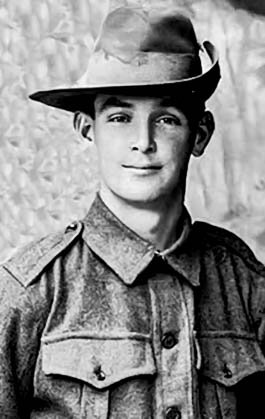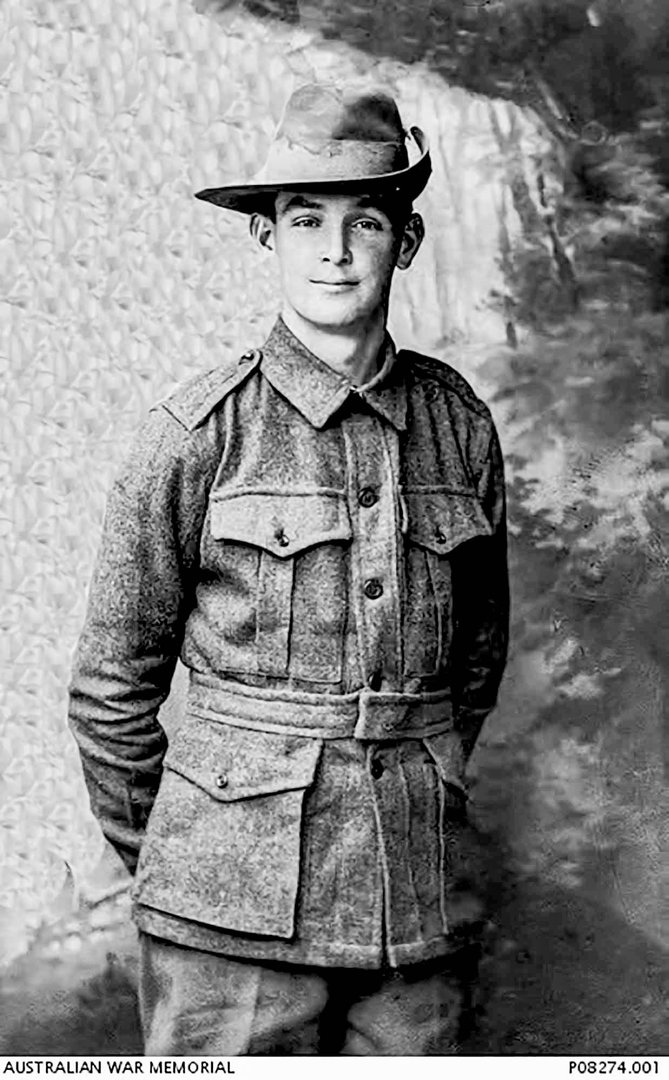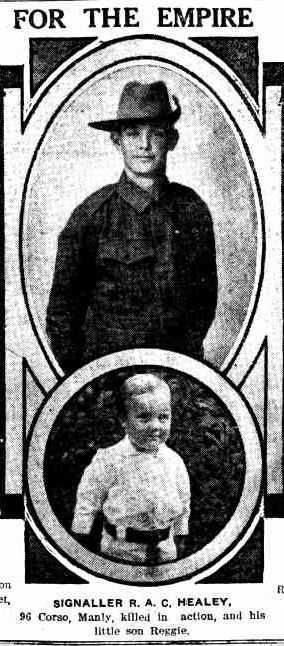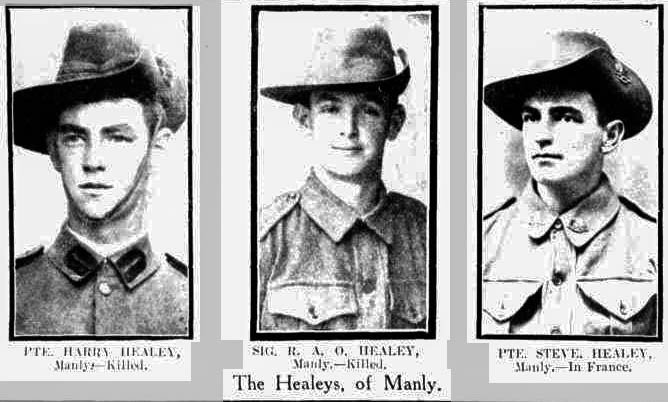Reginald Alfred Charles HEALEY
Eyes brown, Hair brown, Complexion fresh
New Recruit Reginald Healey – Husband, Son and Father
When Reginald Alfred Charles Healey, known as Reg, enlisted on 25 July 1915, he was 25 and a half years old, 5 feet 6 inches tall, a painter by trade and lived in Manly, New South Wales with his wife of four years, Irene Kennedy. Reg and Irene had two young sons, toddler Reginald born in 1912 and baby Stephen born in February 1915, just months before Reg enlisted.
Reginald Healey was born near Wollongong in 1890. He was the youngest child of pastor and former British soldier (Royal Engineers), Henry Percival Healey (1855-1916) and Rose Ann McCartney. The couple were married in Glasgow, Scotland in 1878 and moved around quite a bit, probably with the army. They had five children in England before the family emigrated to New South Wales in 1886.
After arriving in Australia, a further two sons were born including the youngest, Reg. The Healey family continued their mobile lifestyle living variously between Wollongong, Sydney and Newcastle with Henry travelling a lot for his work as both a house painter and decorator and a Presbyterian lay catechist, preacher and minister. Reg had three sisters, Kate (1878-1949), Alice (1880-1881) and Margaret (1881-1925), and three brothers, Harry (1883-1915), Frank (1885-1928) and Steve (1887-1941).
Henry divorced Rose in 1897 when Reg was about 7 and he remarried in 1902 to Alice Baldock (1875-1959). Three children were born to this second marriage - Percival (1904-1904), Cecil (1905-1981) and Lucy (1909-1995).
It is uncertain what happened to Reg’s mother, Rose, but it seems likely that she died before 1902 as Henry described himself as a widower at the time of his second marriage and Kate noted her mother as being deceased on registration of her marriage in 1903.
Reg’s War
On enlisting, Reg was initially placed in the 2nd Battalion, 11th reinforcements and embarked aboard HMAT A14 Euripides on 2 November 1915 bound for Egypt.
Once in Egypt, he was transferred to the newly formed 54th Battalion. It was during this time that the “B” was added to his service number, presumably because another soldier in the battalion had the same service number. A quick search shows more than 50 AIF soldiers shared Reg’s 3511 service number, so alpha characters were added as needed to reduce the risk of misidentification.
The 54th Battalion was formed during the reorganisation of the AIF following Gallipoli. It was made up of a mix of Gallipoli veterans and new recruits from Australia and became part of the 14th Brigade and the new 5th Division of the AIF. Reg was part of the Headquarters Signals section.
The battalion arrived in Marseille, France on 29 June 1916 and were in the centre left of the Australian assault line at Fromelles on July 19, with Battalions from the 8th Brigade to their left and those of the 15th Brigade to their right. They reached their objective, despite taking heavy casualties, but were withdrawn the next morning. Reg was not amongst them.
Red Cross File - Officers and Mates confirm Reg’s fate
The Red Cross file includes statements about Reginald Healey’s death from various soldiers. This included his brother-in-law Percy Kennedy (3090) and some from his signaling section (631 Oswald Hopkins and 4378 William Lickiss) and others – 3533 William Land, 3157 Frank J Ryan and 2950 Frederick Sarratt.
There were three reports of colleagues from the 54th Battalion personally seeing Reg fall (shot in the head) in the German trenches on the morning of the 20th (Sarratt actually said the 19th but errors were easily made as evidence was collected months later often while the witness was in hospital recovering from wounds); they then had to withdraw and leave his body behind.
Statement dated 8 February 1917 from 2950 Pte F. SARRATT:
“I knew Healey well. He was a H.Q. Signaller and was a married man with two or three children. I was next to him on the 19th July when he was hit by a machine gun bullet through the head. This was at Fromelles. He was on the parapet of a sap in the German line, which we had dug. We had to retire from the German lines and Healey's body was left behind. I turned his body over after he had been hit; he was dead.”
Statement dated 3 March 1917 from 3157 L/Cpl Frank RYAN:
“I saw Pte. Reginald Healey killed on the morning of July 20th, 1916 in the German lines – during the attempted advance at Fromelles. He was shot through the head. There are no details of burial to be given as the ground was lost and the dead were obliged to be left.”
Statement 6 November 1916 from 4378 Pte W.G. LICKISS:
“Healey was killed outright by a bullet in the head at Fromelles. I was close to him. I think he was left in the German line. We had gone over on the 19th, held the German front line trench all night, and retired in the early morning of the 20th. It was on this morning, about 7.0 that Healey was killed. He and I were signallers and in the same section. His brother-in-law, Kennedy, was also of our section, but was not there at the time.”
Red Cross personnel took evidence about missing and killed soldiers and communicated with families to help clarify details where they could. They dealt with grieving families and did their best to dispel rumours and clarify facts. In Reg’s case, they sought in March 1917 to resolve confusion about reports that Reg may have survived and been hospitalised in England, and later receiving a commission.
Red Cross investigations discovered that there were in fact two Reginald Healeys in the 54th at Fromelles. The other was an Irish born Sergeant Major (2551) named Reginald Stafford HEALY. He had enlisted as a private in 1915, served at Gallipoli, survived Fromelles, and was later wounded at Flers and hospitalised in England. He was rapidly promoted and finished the war with the rank of Lieutenant. The adjutant replied to the Red Cross clearing up any confusion on April 8th, 1917 leaving the Red Cross to communicate with the family to dispel any rumour that Reg might be alive as false.
On the homefront
News confirming Reg’s death reached the family within weeks with a death notice appearing in Sydney papers as early as 2 August 1916. For a family to have news of Reg’s death less than two weeks later is truly the exception to the rule in the circumstances surrounding Fromelles with most families waiting months and often over a year to hear news of their loved ones. This is almost certainly likely to be the result of a cable or letter from his brother-in-law, Percy Kennedy, who served in the same unit.
To add to the trauma, the news was received the same day that the family were burying his father, Henry, who had died by terrible coincidence on the same day as his son, 20 July 1916, albeit on the other side of the world. Note that the Roll of Honour notice marks the death of his father and also indicates that Reg’s father-in-law, Thomas E. Kennedy, had enlisted however researchers have yet to find records to confirm this.
Reg’s death left Irene a widow at the age of 26 with two boys aged under four years. Henry’s death left Alice, Reg’s stepmother, a widow with two children aged 11 and 7.
Other Healey family members to serve
All four Healey boys from Henry Healey’s first marriage joined the AIF separately, his son from the second marriage was too young to serve. Henry’s two sons-in-law – husbands to daughters Kate and Margaret - also served as did Reginald’s brother-in-law, Irene’s older brother, Percy Kennedy.
Henry Percival HEALEY (1883-1915)
Henry Percival Jr, known as Harry, enlisted in Helena Vale, Western Australia where he was working on the railways in October 1914. He was a private (service number 1382) in the 16th Battalion. Harry was wounded on April 29, 1915 at Gallipoli and died aboard the hospital ship Devanha on 3 May and buried at sea. He is commemorated at the Lone Pine Memorial at Gallipoli.
Harry’s father had a terrible time discovering his son’s precise fate from authorities (though he did receive letters from other soldiers) and in regaining Harry’s personal belongings. Harry’s AIF files contain numerous letters from Henry senior to the army over nearly a year. It would seem that the AIF was totally unprepared for the losses suffered at Gallipoli. Henry did eventually receive confirmation and took delivery of Harry’s meagre personal effects – toothbrush, penknife and strap.
Sadly, after the war, there was a repetition of miscommunications between the authorities and the family with service medals and memorial plaque issued incorrectly to Harry’s widowed stepmother. Harry’s brother, Frank, was actually entitled to receive them as the eldest surviving brother but he signed over the rights to them to his sister, Kate, as she and Harry “were very much attached to one another”.
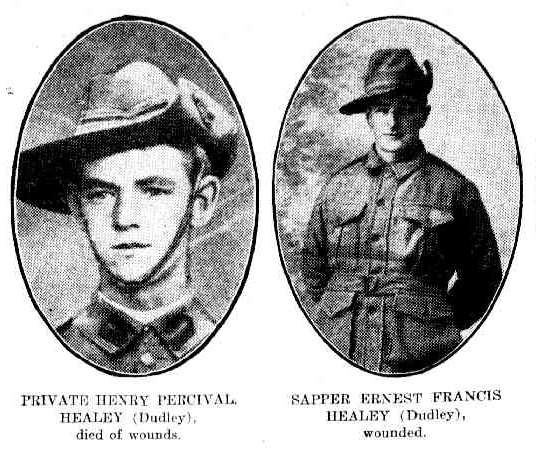
Ernest Francis HEALEY (1885-1928)
Ernest Francis, known as Frank, was a painter and letterer before he enlisted in August 1914 and was a Sapper in the First Field Company, Australian Engineers – service number 98. Both Harry and Frank were wounded in action early in the Gallipoli campaign in 1915. Frank was shot in the back and suffered a spinal cord injury on the first day of the Gallipoli campaign.
He returned to Australia in September 1915 and lived a further thirteen years confined to a bed and cared for by his wife, Daisy, nee Thompson (1890-1948).
Stephen William HEALEY (1887-1941)
Private 2412 Stephen William, known as Steve, and Reg were both painters by trade, both were married with children and living in Manly, New South Wales, and both enlisted in July 1915 – by that time, fully aware of the fate of their older brothers.
Steve was a private in the 19th Battalion. Wounded at Pozieres in August 1916, he later returned to his unit. He was withdrawn from the front in June 1917 on family grounds after he requested that he be removed from combat duties due to the fate of his brothers and father. He was returned home to Australia in September 1917 and discharged.
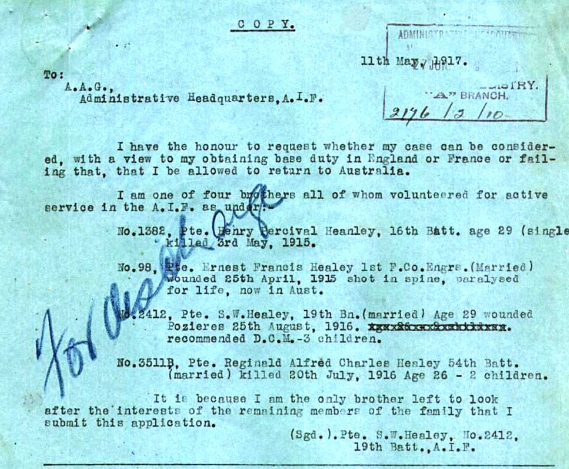
Allan LUMSDAINE (1879-1946) – husband of Kate HEALEY
Allan Lumsdaine enlisted in October 1914 and served in the Australian Army Medical Corps finishing the war as a Warrant Officer; he also served in WWII.
Donald Stuart MacKENZIE (1884-1956) – husband of Margaret HEALEY
Dr Donald Stuart MacKenzie, known as Stuart, enlisted in November 1914 and also served in the Australian Army Medical Corps. He was mentioned in dispatches and awarded the Distinguished Service Order. He finished the war with the rank of Major.
Percy KENNEDY (1887-1982) – brother-in-law to Reg HEALEY
Irene Healey’s brother, 28-year-old 3090 Percy KENNEDY, a telephone mechanic born in Newcastle (NSW), served with Reg in the 54th Battalion H.Q. Signals section. He enlisted the week before Reginald and survived the war, finishing with the rank of corporal.
Reg’s family after the war
After Reg’s death, Irene Healey raised their two sons, Reggie and Stephen, remarrying twice more but having no further children. In 1918, Irene had married former soldier, James Shearer, but he died in 1919 from the same illness that had led to his discharge from the army. His funeral notice mentions that they lived in a house called “Fromelles”. It is possible (but not confirmed) that this house was given to Irene on favourable terms as a war widow, one of five built in her street by the Voluntary Worker’s Association.
Irene married again in 1921 to Clarence Ferrett and moved to Fernmount on the New South Wales north coast. They returned to the Manly area around 1928. Irene died in 1966 aged 76.
Seeking DNA after the discovery of the mass grave at Fromelles
With the work done by Lambis Englezos and others on the mass grave found at Pheasant Wood, there was a chance that Reg’s final resting place may be able to be confirmed.
By 2009, there were six branches of the family tree originating with Henry Percival Healey, three from sons and three from daughters. From the first family, Kate, Margaret, Steve and Reg had children. Harry was never married and Frank and his wife, Daisy, married just before he shipped out in 1914 had no children. From the second marriage, Cecil and Lucy both married and had children. So, despite suffering quite badly as a result of the war, the Healey family did go on to produce a large family tree.
From a DNA perspective, the main research focus has been on those originating with the sons. Extensive research was undertaken using a range of freely available resources, cross-referencing information and contacting descendants on different family lines.
Contact was made with two branches of the tree in 2018 by researchers from the Fromelles Association. Both branches were aware of Reg but did not know much about the wider family and, despite living quite close, were not in touch with one another. Both were also quite interested and excited that he might be identified.
The first contact was with the granddaughter of Stephen William Healey. She indicated that there had been previous contact in 2009/2010 by a stepdaughter of Reginald’s youngest son, Stephen Edward, who seemed to be unaware that Reginald did in fact have a grandson. A DNA sample provided by a grandson of Stephen William was not a match but the contact provided photographs and helped to fill in some areas of the family tree.
The second contact was with the wife of Reginald’s grandson. This contact resulted in a DNA sample being donated by her son, Reginald’s great grandson. It is hoped that this sample will be successful as it comes from Reginald’s direct male line.
On the female lines, a third contact was subsequently made with the granddaughter of Margaret Mackenzie (nee Healey) via a WikiTree reference to her family. Her modern family knew very little about the Healeys as Margaret, who had three children, died quite young and her husband remarried and had more children.
Conclusion
There appears to be little doubt that Reginald Healey was killed by enemy fire in the captured German trench on the morning of July 20th, 1916, shortly before his unit was withdrawn, and that his remains were left behind, intact. Through careful work, cross-referencing various records and sources it has been determined that six of his father’s male and female lines continued and most likely still exist today, and that as part of that family tree Reginald’s own direct male line still exists.
It is hoped that the DNA of his direct male heir(s) will provide a match and that Reg may finally be identified and laid to rest under a headstone bearing his name.
Seeking DNA Donors

Contacts
(Contact: carla@fromelles.info or geoffrey@fromelles.info).
(Contact: army.uwc@defence.gov.au or phone 1800 019 090).
Donations
If you are able, please contribute to the upkeep of this resource.
(Contact: bill@fromelles.info ).
